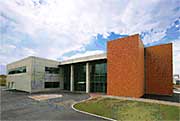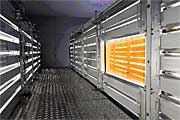Since 1997, Yamaha Motor Co., Ltd. (the ”Company”) has been pursued independent biotechnology research and development. The Company took special notice of astaxanthin for its exceptionally strong antioxidant activity, and moved to commercialize the substance. Yamaha Motor established the world’s first system for volume indoor cultivation, which has made it possible to mass-produce a stable supply of high-quality astaxanthin. The Company will launch an exclusive new biotechnology business when it begins offering astaxanthin to supplement, food and cosmetics manufacturers later this year. It plans to kick off full-scale operations in October 2006.
During the course of its engineering studies over the last eight years on methods to reduce environmental impact - such as developing engines with lower carbon dioxide (CO2) emissions; improving fuel efficiency; and developing electric vehicles and fuel cells - the Company successfully developed technologies for absorbing and fixing carbon dioxide (the photosynthesizing function of plants) using microalgae. The microalgae studies, in turn, gave rise to a new area within the biotechnology business ? developing high value-added natural substances produced by photosynthesis, including astaxanthin.
|
Astaxanthin is an antioxidant pigment found in microalgae such as Haematococcus algae. Its strong antioxidant action is linked to anti-inflammatory activity, and may have a role in strengthening immunity, slowing the aging of skin (age spots and wrinkles) and alleviating muscle fatigue. It is attracting a great deal of attention, not only in the health food market, but in the sports and beauty markets as well.
The Company has developed the world’s first production system for indoor cultivation of Haematococcus algae, called the ”Yamaha High-efficiency Bio Reactor,” using artificial light and advanced fluid control technology. The Bio Reactor makes it possible for the Company to constantly grow a high-quality version of Haematococcus algae, which contains a higher concentration of astaxanthin. Meanwhile, the Company formed an alliance with the Nisshin OilliO Group, Ltd. to develop an extraction process that can supply the market with products of 8% or higher astaxanthin concentration, a substantial improvement on currently available 5% extractions. Thus, the Company’s astaxanthin business offers the advantages of stable supply and high quality. It will be marketed to select businesses within the year, and will also be available to consumers in the form of supplements. |
 |
|
As the Company expands its biotechnology business, it is building a Life Science Laboratory on a 37,000 m2 site in Fukuroi City, Shizuoka Prefecture, Japan - scheduled for completion in July. A large-scale production plant will also be built on the site in October 2006 to get mass production underway.
After breaking into the health food market with astaxanthin, the Company intends to continue its commitment to R&D, and further expand its biotechnology business.
|
 |
 |
Life Science Laboratory
-the R&D base for the biotechnology business |
|
■ Yamaha Motor’s Challenge for the Next Half Century |
 |
On July 1, the Company celebrated its 50th anniversary. The Company’s first half century has been a history of challenges, expressed as new dreams and goals, aimed at realizing the corporate mission of ”touching people’s hearts.” From the time it started with motorcycles, the Company has been successfully diversifying its business to create new value, the bedrock of today’s Yamaha Motor, a global company offering products and services that meet market needs.
In its 50th anniversary year, the Company is launching a new three-year medium-term management plan, ”NEXT50-Phase II,” designed to build on the profitable structure the Company established in the previous three-year medium-term management plan. With NEXT50-Phase II, the Company is implementing a business strategy that balances value, profitability and growth, thus aiming to make Yamaha an exclusive brand in the global marketplace.
The biotechnology business is a new venture aimed at achieving one of the Company’s three management goals- growth - and represents a key new challenge for the next half century. |
■ What Is Astaxanthin? |
 |
Astaxanthin is a carotenoid and a natural red pigment. It occurs in a variety of aquatic wildlife, including crustaceans such as krill and prawns, and fish such as salmon, and is found in high concentration in Haematococcus algae.
Astaxanthin has antioxidant effects, and scavenges for reactive oxygen and free radicals, which are thought to advance aging and increase the risk of lifestyle-related diseases when present in excess. Thus, astaxanthin is expected to have a variety of positive effects, including decreasing these disease risks.
|
■ Three Key Technologies in Yamaha Motor’s Biotechnology Business |
 |
The Company has developed three key technologies for the more efficient absorption and fixation of carbon dioxide, designed to reduce environmental impact: (1) advanced microalgae screening and selective breeding technology; (2) water environment control technology for optimizing culture medium composition; and (3) a photosynthesizing device that can culture microalgae efficiently, in high density, on a large scale. Integrating these three key technologies is the basis of the Company’s current biotechnology business. |
■ The World’s First Large-scale Indoor Cultivation System |
 |
Capitalizing on its three major biotech technologies, the Company has successfully developed the world’s first system for culturing Haematococcus algae indoors, the ”Yamaha High-efficiency Bio Reactor.” |
The Bio Reactor is plate-shaped, measuring about two meters high and about nine meters long. Its interior is filled with culture medium, on which a mass of Haematococcus algae floats. Photosynthesis consists of two stages: light reaction and dark reaction. The key to efficient photosynthesis is repeating the two stages in an appropriate cycle. The Bio Reactor accomplishes this cycle optimization by irradiating artificial light from the side and agitating the culture medium moderately, thus achieving high-efficiency photosynthesis activity.
By using an artificial light source in combination with an indoor type device, the optimum amount of light can be supplied whenever necessary, regardless of the season or weather. Furthermore, the closed structure prevents the culture medium from being contaminated by external factors, making it possible to consistently produce a high quality biomass of Haematococcus algae with a high degree of hygienic control.
A production system incorporating the Yamaha High-efficiency Bio Reactor will be established at the large-scale plant to be constructed in Fukuroi City.
|
 |
 |
Newly developed Yamaha High-efficiency Bio Reactor
|
|
Photosynthesis consists of two stages: light reaction and dark reaction. In the former, light energy is used to split water into hydrogen and oxygen, and at the same time, it is converted into chemical energy and stored by enzyme action. In the dark reaction (so called because it does not need light energy), high value-added substances such as glucose and protein are synthesized by the stored hydrogen and chemical energy, and CO2 taken in from the air. |
■ Stable Supply of High-quality Astaxanthin Using Proprietary Yamaha Production Technology |
 |
Haematococcus algae, which is cultured in large quantities, goes through solid-liquid separation, drying, cracking, and filtration processes to become a high-concentration astaxanthin extract. The process from indoor cultivation to cracking is managed by the Company, while extraction and further downstream processes are managed by its alliance partner, Nisshin OilliO Group, Ltd. Due to its antioxidant property, astaxanthin easily oxidizes, or decomposes. Yamaha’s advanced technology, however, makes it possible to commercialize astaxanthin without sacrificing quality. At the production plant, a good manufacturing practice (GMP) - comparable to the GMP used for medicines - will be employed, and a production tracking system will be established to trace the complete process, from cultivation through shipping. |
 |
|
Astaxanthin extract production processes
|
■ Studying Astaxanthin’s Effective Properties for Human Health |
 |
The Company is also conducting studies to verify astaxanthin’s effectiveness. Some of the research is conduced independently, while some is being done in collaboration with a research network including Biomarker Science Co., Ltd. Results will be publicized at scientific forums and symposia. |
■ Building the Biotechnology Business of the Future |
 |
The Company’s biotechnology business has three phases.
Phase 1 was the development of a rare aqua-culture supplement. The Company successfully cultivated highly concentrated Chaetoceros algae (diatoms on which shellfish and crustaceans feed) in large quantities, an achievement that had previously been very difficult. The level of concentration was six times that achieved by conventional technology, or 60 million cells per milliliter.
Expanding the business with astaxanthin is Phase 2. In addition to the work with astaxanthin, there is another research program to develop useful substances, such as an allergy-free algae beta-chitin, for a possible business in the future.
Phase 3 will see advanced technological development, further R&D, and more business expansion. The Company aims to apply its biotechnology expertise and advance overseas to grow the business to 30 billion yen within 10 years. Ultimately, it seeks to achieve the overarching Yamaha Motor objective: ”Delivering a new level of excitement and helping bring fulfilling lives to people the world over.”
|

|